
Researchers from all over the world are gathering at Florida State University for a major international conference that focuses on predicting the properties of materials and finding new ways to improve these properties.
More than 500 materials science scholars and professionals are exchanging research findings related to complex materials problems and development of innovative theoretical and computational concepts, and addressing issues of importance to practical applications of “multiscale materials modeling” at the conference dubbed MMM2008, being held Oct. 27-31 at the Tallahassee/Leon County Civic Center.
FSU’s new Department of Scientific Computing, formerly the School of Computational Science, is hosting the event after Professor Anter El-Azab led the team that presented the winning proposal at the conference’s previous meeting in Germany two years ago. El-Azab, who directs a materials modeling and simulation lab at FSU, is the conference chair.

“To be chosen to host a meeting such as this one, an organization and its people have to have a worldwide reputation in the subject matter,” said Max Gunzburger, chair of the Department of Scientific Computing. “This is recognition by the international research community of FSU’s strength in materials science and Professor El-Azab’s reputation as a leader in that community.”
In a world where new technologies and products depend on the use of materials that are lighter, stronger, smaller and more flexible, scientists must be able to predict how different materials, including metals, glasses, ceramics and various composites, act under different conditions, at both the atomic or molecular level and at the macroscopic level; in other words, multiscale.
“If one wants to use a material in, say, a jet engine, how the material reacts to high temperature and mechanical forces may depend on what is happening at the molecular level,” Gunzburger explained. “Thus, one has to know the material response at lengths ranging from the size of the engine component down to intermolecular distances.”
Increasingly, scientists are modeling the behavior of materials in different environments by using sophisticated mathematical and computational algorithms. This development has attracted mathematicians and computational scientists to the multiscale materials modeling field, which is a new science and engineering frontier that transcends the boundaries between the traditional disciplines of mechanics, physics and chemistry of materials.

“The increasing interest in this field by mathematicians and computational scientists is creating opportunities for solving computational problems in the field with an unprecedented level of rigor and accuracy,” El-Azab said.
Computational algorithms are especially emphasized in this year’s conference program, “Tackling Materials Complexities via Computational Science,” which is inspired by the research mission of FSU’s newly created Department of Scientific Computing.
The conference includes symposia with focus areas in statistical models of materials, mechanics of materials across scales, computational materials design and biological and soft matter response, as well as the response of materials under extreme conditions in the nuclear reactor environment.
FSU Francis Eppes Professor of Chemistry and Biochemistry Harold Kroto, who won a Nobel Prize in 1996 for his co-discovery of “buckyballs,” will give the opening plenary on “Architecture in Nanospace” at 9 a.m. Oct 27.
Other speakers making presentations throughout the conference include Nasr Ghoniem, University of California Distinguished Professor at the University of California, Los Angeles; Subra Suresh, the Ford Professor and Dean of the School of Engineering at Massachusetts Institute of Technology; Stephane Roux, a professor at Ecole Normale Superieure de Cachan; and Bennett C. Larson, a corporate fellow at Oak Ridge National Laboratory.
For more information about the conference, visit www.MMM2008.org.




